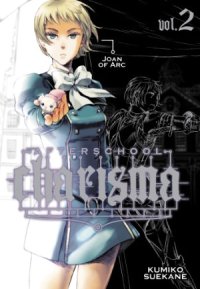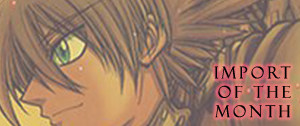RIGHT TURN ONLY!!
Afterschool Hetalia
by Carlo Santos,

A new year! A new column!
What do you hope for in 2011? Do you hope that Bill 156 will be overturned? Do you hope for someone to license your favorite series-that-no-one-else-knows-about? Do you hope your local convention will invite over your favorite manga-ka as a Guest of Honor?
Whatever your hopes are for the new year, may 2011 bring them all to you.
AFTERSCHOOL CHARISMA

Vol. 2
(by Kumiko Suekane, Viz Media, $12.99)
FROM THE BACK COVER:
"St. Kleio Academy is a very exclusive school. To enroll, a student must be the clone of a famous historical figure. Wolfgang Mozart, Queen Elizabeth, Sigmund Freud, Marie Curie, Adolf Hitler—with such a combustible student body, it's only a matter of time before the campus explodes!
Joan of Arc (1412-1431): A patriotic young French maiden. After beginning to hear voices at the age of 13, Joan led the French army in the liberation of Orléans in the Hundred Years' War against Britain. But not long afterward, she was convicted of heresy by a religious tribunal and burned to death at the stake."
EVIDENCE FOR:
Despite Afterschool Charisma's white, male, Eurocentric last-500-years view of world history, it is still able to touch upon some thought-provoking universal truths—especially with the mysteries of life and death growing ever deeper in Volume 2. The idea of a high school populated by famous clones has instant appeal, of course, but the real hook of the series is the existential brooding that lurks between the storylines. Whether it's Mozart's suicide attempt, or Joan of Arc taking part in a symbolic ritual to try preventing her teenage martyrdom, there are plenty of big ideas at play here: ideas of predestination, choosing your own future, originals versus clones, and the value of human life. The ongoing threat of a secret organization trying to kill all the clones, plus an ominous school fad involving cute little sheep charms, adds suspense to the storyline as well. But there's also humor to be had when the school's flamboyant director stops in for a visit, and who can resist the clean linework and pretty-boy character designs for the series' main cast? The sure-handed visual style, combined with mind-bending plot developments, is sure to keep readers hooked throughout Volume 2.
EVIDENCE AGAINST:
Isn't a story supposed to get more intense and exciting as it progresses? Then how is it that Volume 1—which at least had the Clone Kennedy assassination—turned out to be a veritable thrill ride, compared to these six chapters of endless foreshadowing? While it may be fun to watch the different threads of plot weave and wend their way around each other, if there's no payoff (even a partial one), then the building up of tension has no point. And that's the problem with this volume, where Joan of Arc is about to engage in her sacrificial ritual, and the school festival is about to take place (with ensuing student drama), and the bad guys are about to make their next move. At the same time, the villains are far from compelling, due to the lack of exposition about who they are—aside from shadowy faces talking about how they plan to kill the clones at school. The artwork is also lacking in certain details—the avoidance of backgrounds and formulaic style of character design (all the guys look like Code Geass doujinshi characters!) often cross the threshold from clean-lined attractiveness into blandness.
FINAL VERDICT:
It's still a great premise, with a lot of big ideas to prop up the story, but this volume fails to deliver any critical heart-stopping plot points or brilliant artistic moments—which is why it gets a C+.
AION

Vol. 1
(by Yuna Kagesaki, Tokyopop, $10.99)
FROM THE BACK COVER:
"Mermaids and mind-controlling parasites wage war in this much anticipated series from the creator of Chibi Vampire! Tatsuya Tsugawa has just lost both of his parents in a car accident. While trying to live up to his father's dying wish of becoming an upstanding man, Tatsuya rushes to help Seine Miyazaki—his bizarre classmate—from bullies. Little does he know he is about to find himself in the middle of a supernatural war between the immortal Seine and sea creatures that can control humans. So much for being Mr. Nice Guy!"
EVIDENCE FOR:
It may have nothing to do with a feuding family of vampires, but AiON proves that the wheels in Yuna Kagesaki's head just can't stop turning. An average storyteller could have settled for any one of these ideas: mysterious parasites invading people's heads and turning them evil ... or a curiously immortal girl who fights supernatural invaders ... or a recently orphaned boy who must protect his inheritance from scheming relatives ... but Kagesaki weaves all of them into a single, suspenseful first volume. Readers can look forward to a fast-paced thrill ride where the mood is constantly shifting, and where surprising events keep the pages turning—if it's not people threatening to kill each other, it's people (or one person, at least) coming back from the dead. Miyazaki's eccentric behavior also adds some comedic charm to the story, and Tatsuya's humble heroism as a guy who just wants to do the right thing makes him a likable character too. And while the pages have plenty of action going on, the clean, straightforward layouts make it easy to follow—so that the story can take the position of prominence it deserves.
EVIDENCE AGAINST:
She may have all these great story ideas up her sleeve, but Yuna Kagesaki really ought to trade some of them for good character designs one of these days. Visually, the cast of AiON is about as distinctive as mass-produced canned meat, what with the Typical High School Boy and Typical (But Eccentric) High School Girl and Average Aunt and Uncle playing starring roles. And really, it's something that could be said about the art in general: polished enough to do the job of telling the story, but lacking in any standout stylistic flair. On the other end of the scale, though, we have the storyline being too imaginative to the point where some subplots seem like unnecessary baggage. Take, for example, Tatsuya's father's dying words about growing up to be an exemplary young man—by the later chapters it starts to feel like a quotation that's just there for the sake of being there. And the bullying-related drama that starts out the series ends up being ... well, not the point of the series. Sometimes, the key to having a fountain of story ideas is knowing when to stop.
FINAL VERDICT:
The fantastical mix-and-match of ideas guarantees plenty of things going on, but the plain artwork and unbalanced overload of subplots make it a C start to the series.
CHI'S SWEET HOME

Vol. 4
(by Konami Kanata, Vertical, $13.95)
FROM THE BACK COVER:
"Welcome to the neighborhood, Chi and family! Now in her new residence, Chi will be introduced to many friends of the furry and feathery kind. With so many fresh smells to investigate, endless adventures await. So settle in, because here pets will never be chased ... unless they are chasing each other."
EVIDENCE FOR:
Don't ever let anyone accuse Chi's Sweet Home of "getting old" or "doing the same thing over and over"—not when Volume 4 is all about new experiences and new friendships. This installment carries over flawlessly from the last book, with Chi and the Yamadas moving house exactly as planned, and Konami Kanata documenting it from a uniquely feline point of view. Chi's bewilderment in the early chapters is a nonstop source of amusement, going from "This is my home, but who packed up all the furniture?" to "This new place isn't my home, I only recognize the smell of my owners" to "Whoa, this place has STAIRS!" And even after Chi has settled in, there's plenty of excitement to had with moments like Chi getting her nails trimmed—an intense physical battle between cat and human—and accidentally trapping herself in a drawer during a game of hide-and-seek. A twinge of homesickness right at the end also reminds us that this typically cheerful series has its moody, introspective moments too. As usual, Chi's wild expressions and animated behavior are a delight to for the eyes, as are the bright colors and clear layouts on each page.
EVIDENCE AGAINST:
Oh Chi, you were starting to get all dramatic and interesting—and now the series has regressed. Where the previous volume looked into the fears and anxieties of giving up a pet and giving up a home, Volume 4 shows the prompt resolution of that arc and fails to go any deeper than that. Chi's exploration of her new living space provides some amusement, but after that it's just the same old romping around the house, craving attention and having lighthearted animal encounters. Aside from the claw-trimming and drawer incidents, there's just no tension, no Cat vs. World conflict, to keep readers interested. And it's not like Chi's newfound friends are much help, either: one neighbor's dog lacks the intellectual power to be of any use (aside from harassing Chi for about one chapter), another neighbor's cat is too snooty to engage in discussion, and the other folks next door have a bird, which Chi only sees as food. Whatever happened to the existential musings of a great supporting character like Blackie? Or the action-packed quest to avoid a nosy superintendent? We know what Chi is capable of. But this volume just doesn't show it.
FINAL VERDICT:
Although not as effective as the previous installment, there's still enough charm and humor to earn a B-. But for goodness sakes, someone get Chi a new friend already!
HETALIA AXIS POWERS

Vol. 2
(by Hidekaz Himaruya, Tokyopop, $10.99)
FROM THE BACK COVER:
"World War what? It's all about getting to know each other (or at least trying to) in this hilarious second volume of Hetalia Axis Powers! And with the Hetalia Academy, tons of new character introductions along with preparing for the Olympics, there's no time left of the battlefield! But leave it to Italy's ancestor, 'that jerk' England, and pushy America to stir things up while good old Canada, quiet Japan and Sweet little Liechtenstein respectfully go about their day. Isn't it about time they all started getting along?"
EVIDENCE FOR:
With 195 countries in the world as of right now, it's practically impossible for Hetalia to run out of character ideas—and indeed, Volume 2 works best when adding new nations to the fray. While heavy hitters like Germany, Italy, Japan, America and England are still entertaining, it's the mix of trivia and sketch comedy about places like Switzerland and Liechtenstein, Ukraine and Belarus, and even poor, overlooked Canada that brings variety to these pages. Of course, with places like these it's a little harder to come up with broad ethnic gags, so Hidekaz Himaruya turns to a more sophisticated level of humor: referencing political and historical situations that turn out cute and hilarious in gag form. It's hard to forget Russia and Belarus's bizarre relationship when framed in the context of incest, for example, and even well-known swatches of history like the European colonization of the United States takes on a fresh sparkle in Himaruya's imagination. That imagination also brings new twists to the 4-panel format: sometimes the joke is told in 2, 3, or 5 panels, or sometimes he's got 2 columns running simultaneously—whatever it takes to bring the funny. And Hetalia brings plenty of funny.
EVIDENCE AGAINST:
But what price humor? For all its flashes of brilliance, this volume of Hetalia also drags through a number of dull spots, like the "guy walks into a café" segments (ethnic gags at a low, uninspired level) and the ongoing bickering between the Axis Powers, which hasn't really progressed as a subplot since Germany, Italy and Japan first met in Volume 1. In fact, that's the trouble with the top-tier characters in general—they've become one-note jokesters who are simply holding the series back. All the cool, new stuff is happening with the itty-bitty unpronounceable European territories, while the mainstays of the franchise are mired in repetitive material like "Japan is polite" and "America is loud" and "nobody ever notices Canada." And it's not like Himaruya can get away with adding new countries forever—the extensive profile page at the start of the book, longer than some explanations of the Gundam universe, should prove that we are already overloaded with characters and many of them are barely distinguishable from each other. Of course, the sloppy art and cramped panels also contribute to the problem; any webcomicker who earns the privilege of hard-copy publishing really ought to think about cleaning things up first.
FINAL VERDICT:
Despite some charming segments with new characters and new historical lessons, the overall product lacks polish. With this kind of scattershot humor it only gets a C.
HYDE AND CLOSER

Vol. 3
(by Haro Aso, Viz Media, $9.99)
FROM THE BACK COVER:
"Shunpei Closer has low self-esteem and doesn't seem to be good at anything. His teddy bear, Hyde, was a gift from Shunpei's grandfather, Alsyd Closer, who was the King of the Sorcerers. After a mysterious attack, Shunpei learns that he is the target of sorcerers all over the world. With Hyde as his main protector and teacher, Shunpei must learn how to gain confidence in himself and use the magic that he has inherited to battle the dark forces that now threaten him.
'Eat Shunpei's heart and gain the power of the King of Sorcerers...' The source of this rumor is finally revealed as Shunpei faces new enemies. What is the dark ambition of the stranger known as the 'Watcher in the Window'?"
EVIDENCE FOR:
When it comes to magical combat, no series quite matches the variety and pure fun factor of Hyde and Closer—it doesn't require a degree in Latin, or demand an intricate knowledge of Japanese folklore, or dissolve into brute-force punching and kicking like some kind of Mixed Magical Arts. No, it's simply about finding the most creative way to blow the other guy up: Hyde tries out a magical cell phone that deflects anything thrown at it; a humanoid ramen bowl takes its power from boiling water; another enemy mind-controls her enemies through the booty-shaking rhythms of reggae. Now isn't that a lot more fun than random wand-waving and incantations? The sheer variety of characters also demonstrates Haro Aso's ingenuity as a creator: an insecure young girl who makes curse items and a feisty Latin American beauty are two of the new additions that make the cast more colorful. Plus the back-story on Hyde in the final chapter is a must-read for anyone wanting to look deeper into this universe. Appealing character designs and dynamic fight sequences also add the necessary visual pop to make this an ideal action-sorcery series.
EVIDENCE AGAINST:
In the end, fun and variety (and cute character designs) only go so far, and readers hoping for a truly grand sorcery saga will have to keep on looking—at least if Volume 3 is anything to go by. This ought to be the time that the Hyde and Closer universe starts expanding with new plot advancements, but instead, it seems content to keep throwing out new magical powers just for giggles. Hyde's newest ability, for example, is not the result of diligent training or brainpower, but a flukey magical charm that conveniently starts working at the exact moment he needs it. And the reggae-blasting adversary that takes up the second half of the book? Her sorcery consists of nothing more than attacks of increasing power on a one-two-three scale, and she never acts as if she really wants to be taken seriously. There is no deep, carefully thought-out basis for any of this magic; just scattershot ideas of what might look cool on the page. And you can forget about character development with the all-style-no-substance stereotypes that star in this volume. Ultimately, the series sticks to the old villain-of-the-week formula—and appears doomed to continue plodding along that way.
FINAL VERDICT:
This one is lucky to scrape by with a C-. If the art weren't so dynamic and appealing, the grade probably would have dropped even further with that silly, aimless story bogging it down.

SOREDEMO MACHI WA MAWATTEIRU (But Still the Town Turns)

Vol. 1
(by Masakazu Ishiguro, Shonen Gahosha, ¥533)
FROM THE ENCYCLOPEDIA:
"Clumsy Hotori Arashiyama is a girl with a love for mysteries and a knack for getting into trouble. Hotori works as a waitress in an unsuccessful coffee shop when the manager comes up with a plan to increase its fortunes by changing into a maid cafe. Unfortunately, no one knows how to make a successful maid cafe other than dressing everyone in a maid outfit. What follows is a wacky series of incidents involving Hotori's many friends, mismatched love stories ... and ghosts and aliens."
EVIDENCE FOR:
Want to know Masakazu Ishiguro's secret? He's not really into maid cafés. Yet it is that outsider's perspective that makes SoreMachi the smartest, most perceptive take on maid culture since Emma—not to mention a smart, perceptive take on life in general. Instead of pandering to the fetishes of fans, Ishiguro's slice-of-life comedy takes a deadpan approach to the daily proceedings of the Seaside Café, where Hotori bungling an order or spacing out in mid-thought is far more likely than a saccharine "Welcome home, master." Snappy conversational comebacks, tongue-in-cheek wordplay, and rapid-fire acts of slapstick are also part of SoreMachi's comedic language—and it doesn't just happen at the café, but on Hotori's shopping trips, at school, and at home. Whether she's debating the laws of math with her teacher, or trying to keep her younger siblings under control, Hotori's embattled, everygirl demeanor is instantly likable. Confident linework and distinctive character designs give this series a strong visual component as well, and the dramatic shifts between idyllic town life and madcap, speedline-driven action create a delicate balance between calm and frenetic on each page. And so, the town still turns—on an axis of precisely executed comedy.
EVIDENCE AGAINST:
The series' comedic wheels keep turning, but where is it actually going? That seems to be the question SoreMachi refuses to answer in its first volume, choosing instead to stick its fingers in all the pies as a way of avoiding commitment to any particular creative direction. It's a workplace comedy! No, it's about high school romance! No, it's a domestic sitcom! Sure, each of these different styles is handled competently, but the overall product ends up feeling scattershot and shallow as a result. The love triangle that links Hotori and her other schoolmates, for example, gets a charming treatment but never progresses as a romantic storyline. The quest to transform the Seaside Café into a proper "maid cafe" provides an amusing first chapter or two, but eventually gets derailed when Ishiguro decides that there are other topics of amusement worth tackling. And Hotori's siblings, irritatingly cute as they are—just read the Space Explorers chapter—appear in the story too sporadically to feel like genuine, established characters. If only the manga-ka could finish what he started and decide where he wanted to go with all this ...
FINAL VERDICT:
If a strong, cohesive narrative is a big deal to you, then this series might be a disappointment. But as a witty slice-of-life comedy with lots of varied characters and themes, plus instantly enjoyable artwork, it's sure to please.

Looking for an underrated, overlooked series that's never been covered in this column? Never fear, that's what the latest Reader's Choice is all about! Adam Wescott wants everyone to know about this masterpiece of shoujo fantasy. And if your favorite manga is still invisible on RTO, you should be submitting a review too!
BASARA

Vols. 1-27
(by Yumi Tamura, Viz Media, $9.95/$9.99 ea.)
Basara is post-apocalyptic Shakespeare. Set in a Japan ruled by a tyrannical Emperor and his sons, it begins with a prophecy proclaiming the birth of a Child of Destiny in the desert kingdoms, who will one day rally the people and overthrow the empire. When the child, whose name is Tatara, becomes a teenager, he is killed by soldiers of the Red King, least-loved son by the Emperor. But Tatara has a twin sister named Sarasa, who takes Tatara's name and leads what remains of her people against her brother's murderers and, ultimately, the Empire itself. This revolution slowly spreads from Sarasa to her friends to, eventually, all of Japan. Also, Sarasa and the Red King fall in love without either knowing the other's identity. This is a shoujo manga, after all.
Basara gets two, very crucial, things right. The first is the scale. Basara is unabashedly epic in the way that very few comics are, spanning all of Japan and encompassing a cast of characters that numbers in the dozens. Many of these characters are larger than life: Sarasa is the most capable female protagonist since Nausicaä, and her love interest Shuri is the male lead to end all male leads. Asagi the wanderer is a badass, pirate woman Chacha is a badass, even scatterbrained archer Hayato has moments of badassery. Even more remarkable is the fact that there are very few pure villains—almost every character established as "bad" at the beginning of the series proves to have a lot more depth to them than initially thought, from the Red King on down. Not to mention the fact that Basara has more competent female characters living and fighting in one series than almost any other manga I've read.
The other thing that Basara gets right is intimacy. Basara is a shoujo manga, and so while there is awesome posing and kinetic battle scenes there is just as much focus on character interaction, on the subtle dynamic between friends and allies and lovers. The length of the series gives almost every character enough time to develop, and by the time it is over you feel for everybody, even for those with only a few volumes of screen time.
A more jaded reader could say that Basara is too emotionally intense, to an unrealistic degree. There is truth in this. But it is also unabashedly romantic, not only in the relationship sense of the word but in every other sense too. There aren't many series these days that combine grand events with small-scale passions to such a degree, but when there are excellent but unloved series like Basara hanging around in the woodwork, who needs those other series, anyway?
Is there a hidden gem of manga you'd like to reveal to the world? Is there a piece of garbage that deserves to be bashed in public? Or is there a title that didn't get a fair grade here, and you want to set the record straight?
Now's YOUR chance to be the reviewer! Write a review of about 300-400 words (a little more or less is fine) and include:
- your name.
- Title of manga (and volume no., if applicable)
- Author/Artist
- Publisher
- Briefly describe the story, then explain why this manga is great, terrible, or in between. Be objective, but also be entertaining.
Then send it in to rtoreaders (at) gmail (dot) com (plain text format preferred). One review will be selected out of all the submissions and will be published in the next column. All types of manga and manga-inspired comickry are accepted, from past and present, from Japan and beyond—what matters is that it's the Reader's Choice! NOTE: Submissions may be edited for formatting and grammar.
discuss this in the forum (15 posts) |